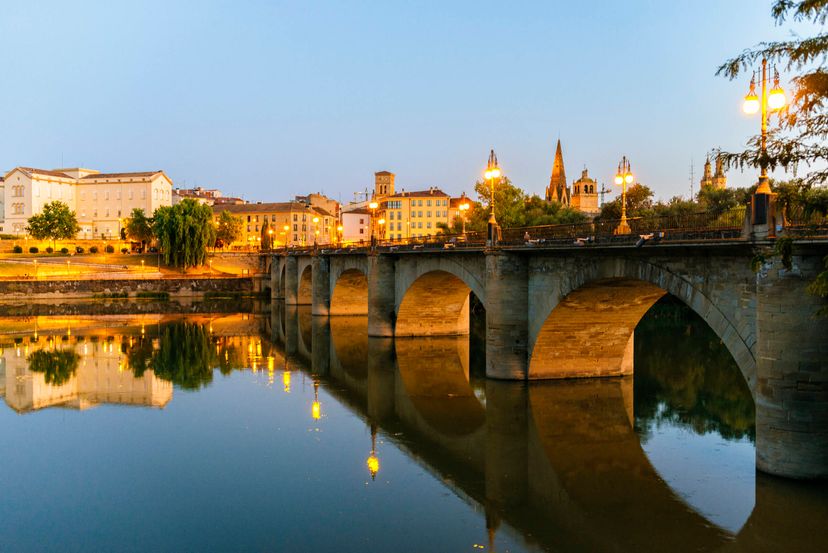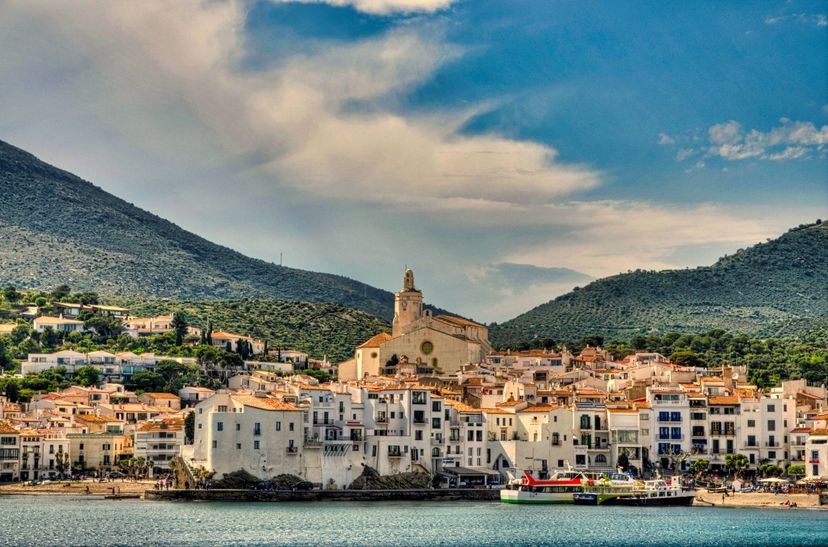
If you’re planning a trip to Spain, the first places you likely think of are the popular tourist cities like Barcelona, Madrid and Seville, however there are many underrated destinations in Spain that are worthy of a visit as well. Whether your taste is beaches, sights, or culture when it comes to travel, Spain has it all and more, especially within its smaller towns. Follow along as we roundup some of the most gorgeous underrated cities in Spain that we know you’ll fall in love with.
Advertisement
12. Granada

Nestled at the foot of Spain’s Sierra Nevada mountains, Granada city is the provincial capital of Granada in Spain’s Andalucia region. Home to the fabled citadel and palace of Alhambra, the city offers visitors an intriguing glimpse of Spain’s Moorish history, which effectively ended when Ferdinand and Isabella marched through the city gate of Puerta de Elvira in 1492. With its beautiful architecture, bubbling fountains, and lush gardens, the 13th-century Alhambra is a must-see attraction. An afternoon spent roaming off the beaten track among the white-washed buildings of the city’s old Muslim quarter is worthwhile as well. Sunset draws visitors to the Mirador de San Nicolás, a paved lookout where crowds gather each evening to watch the Alhambra glow red under the reflected light of the setting sun.
11. Salamanca

Located in central Spain, Salamanca owes its breathtaking beauty to the nearby sandstone quarries from which many of the city’s buildings were constructed. The glowing light that emanates from the stone at sunset has earned Salamanca the nickname “The Golden City.” A university town since 1218, Salamanca is still home to one of Europe’s finest universities. The city is filled with historic architecture, including the 12th-century Catedral Vieja and Casa de las Conchas, a 15th-century structure ornamented with hundreds of sandstone shells. Visits to Salamanca often begin at the Plaza Major, a Baroque square where students gather at all hours to eat, drink, and sing together. Their enthusiasm and confidence offer assurance that Salamanca’s future will be as bright as its golden past.
10. Pamplona

The capital of the Navarra region, Pamplona is known all over the world as the site of the annual “Running of the Bulls” held during the Fiesta de San Fermín. For visitors not interested in risking life and limb dodging bulls through crowded streets, however, you’ll be better off avoiding the city during the week-long festival in early July. Pamplona has plenty to offer visitors the other 51 weeks of the year. In addition to the city’s Old Quarter with its pretty park and historic churches, the Museum of Navarra is a can’t-miss attraction. Housed in a 16th-century hospital, the museum boasts an impressive collection of Roman artifacts and mosaics as well as 13th-century murals, Renaissance paintings, and Goya’s portrait of the Marqués de San Adrián.
9. Bilbao

At first glance, Spain’s biggest port city appears to have little to offer, but visitors who take the time to peer underneath Bilbao’s industrial façade will find much to discover. The city’s standout attraction is the Guggenheim Bilbao Museum, one of architect Frank Gehry’s most spectacular achievements. The unique titanium-clad building is home to more than 100 exhibitions of modern art. A short walk from the museum over the futuristic Zubizuri footbridge leads visitors to the historic Old Quarter, which has several important churches. The restored Santiago Cathedral dates back to the 1300s and exemplifies the Gothic Revival architectural style. The nearby 16th-century Basilica de Begoña features multiple large-scale paintings by the Italian Baroque artist Luca Giordano.
Advertisement
8. Logroño

The northern city of Logroño was once a fortified medieval town, and the city’s Old Quarter is still its greatest attraction. The Casco Antiguo has long served as a stop for pilgrims on their trek to visit the tomb of Saint James at Santiago de Compostela. With its magnificent carvings and statues, the Gothic-style Santa Maria de Palacio is well worth a visit, as is the beautifully sculpted Romanesque front of Church of Saint Bartholomew. As the trade center for wine in the La Rioja region, Logroño is known for its world-class Spanish wines and dining scene as well. Lined with historic gardens, pretty Paseo del Espolón is the best place to join locals for the early evening stroll known as the paseo.
7. Jerez de la Frontera

Most visitors come to the Andalusian town of Jerez del Frontera for its world-famous sherry, but they often succumb to the city’s other charms as well. Jerez del Frontera’s history dates back nearly 3,000 years, and remnants of its past are scattered throughout the city. The city’s star attraction is the Alcazar, a Moorish fortress built-in 1255. The complex features a mosque, Arab baths, and picturesque gardens. Jerez de la Frontera has several themed museums too, including a clock museum, a flamenco museum, and one about the region’s fine wines. The city’s Old Quarter is notable for its Mudéjar chapels and for its archeological museum, which has artifacts ranging from a 7th-century-B.C. Greek helmet to a 15th-century blown-glass ceiling lamp.
6. Girona

Located in Spain’s northeast region of Catalonia, Girona is a small medieval city with a long and unique past. For its ability to withstand invasions from powerful forces for centuries, Girona is known as “The City of a Thousand Sieges.” An exploration of the city’s Old Quarter takes visitors past Roman walls, Moorish baths, and Gothic churches, and it’s easy to get lost in time navigating the labyrinth of narrow alleyways and stone lanes. No visit to Girona is complete without checking off the bucket list goal of climbing the 89 steps to the Girona Cathedral. Here you can view its famous “Tapestry of the Creation,” an embroidered panel that dates back to the 11th century. The scenic riverside “Rambla de la Llibertat,” Girona’s main promenade, is lined with cafés, shops, and restaurants.
5. Valencia

Facing the Gulf of Valencia in the Mediterranean Sea, Valencia has always been one of Spain’s most important cities, but a recent push to bring the city into the 21st century has garnered mixed reviews. Some visitors are thrilled by the futuristic architecture of the new City of Arts and Sciences complex while others still find the atmospheric Barrio del Carmen the prettiest part of the city. The Museum of Fine Arts in Valencia houses an extraordinary collection of Spanish paintings, including works by Goya, Velázquez, and El Greco. Founded in 1567, the beautiful botanical gardens at the University of Valencia are just as impressive.
4. Burgos

The capital of Spain’s Castile region for nearly 500 years, Burgos has played a significant role in the country’s history but still remains relatively underrated. As the home and burial place of the medieval Spanish hero El Cid, the city has long attracted visitors interested in Spain’s rich past. A recent push to recognize Burgos as a designated “European City of Culture” has brought the city’s best historic attractions to the fore. From its towering spires to the slab of marble that marks the tomb of El Cid, the remarkable Cathedral of Burgos has been restored to its Gothic glory. The Old Quarter is surrounded by green spaces, including the beautiful parks on the banks of the Arlanzón River known as the Paseo de la Isla.
Advertisement
3. Ourense

Ourense is a provincial capital in Spain’s Galicia region situated along the banks of the Miño River. The city is best known for its many scenic bridges, some of which date back to the Roman Era. Although surrounded by urban sprawl, the heart of Orense has been lovingly restored and preserved, and wandering through the Old Quarter can make visitors feel as if they’ve traveled back in time. The city’s oddly sloping Plaza Mayor features structures constructed during the city’s 18th-century expansion. Orense is also notable for its “pozas,” hot springs that bubble up to the surface throughout the city, including along the banks of the Miño.
2. Santillana del Mar

Known for its well-preserved medieval Old Quarter, Santillana del Mar is located in the Cantabria region of northern Spain. Despite the “del Mar” in its name, the city is surrounded by land, not water, although the sea is nearby. Set against a backdrop of rolling hills covered with farms and fields, the old city’s cobblestone streets are lined with beautiful sandstone churches and ancestral homes that look much as they did hundreds of years ago. The 12th-century Colegiata de Santa Juliana houses the remains of the city’s patron saint. The prehistoric Altamira Caves on the outskirts of Santillana del Mar are no longer open to the public, but the nearby Museum of Altamira contains perfect replicas of their amazing cave paintings.
1. Huesca

A small town located in Aragon region of northeastern Spain, Huesca attracts travelers who use the city as a base for visits to the nearby Loarre castle or for ski trips in the Pyrenees Mountains, but there are underrated attractions within the city worth seeing as well. The partially restored Old Quarter boasts the 13th-century Huesca Cathedral that features stone statues of the twelve apostles. The main attraction of Huesca is the Abby of San Pedro el Viejo with its picturesque Romanesque cloister. The Miguel Servet Park, the city’s largest public green space, is worth a visit too. The centrally located park features wide lanes lined with mature trees, a wide range of sculptures, and numerous water features.
Advertisement